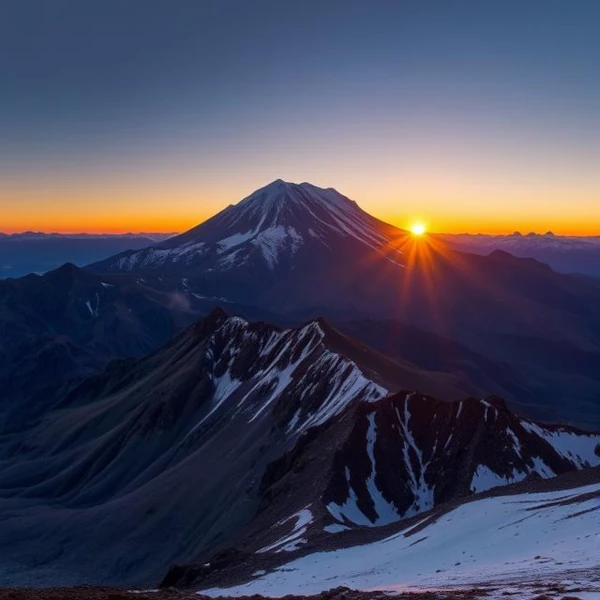
The eruption of Nevado del Ruiz in Colombia on November 13, 1985 is one of the deadliest natural disasters of the 20th century in South America. Although the eruption itself was not extremely violent, the melting of glaciers at the volcano's summit triggered massive lahars (volcanic mudflows) that buried the town of Armero, killing more than 23,000 people. This event marked a turning point in volcanic risk management in Colombia.
Chaitén volcano in Chile erupted unexpectedly on May 2, 2008, after more than 9,000 years of inactivity. The eruption produced an ash column reaching 20 km in altitude, causing major disruptions to air traffic and the evacuation of thousands of people. The nearby town of Chaitén was almost entirely destroyed by lahars and flooding. This eruption reminded the world that even volcanoes considered extinct can awaken.
Nevado del Huila, also in Colombia, erupted between 2007 and 2008, after more than 500 years of dormancy. Explosions and pyroclastic flows caused landslides and lahars, affecting local communities. This eruption highlighted the vulnerability of populations living near glacial volcanoes, where ice melt can exacerbate risks.
Cotopaxi, in Ecuador, is one of the most famous and dangerous volcanoes in South America. Its eruption in 1877 produced pyroclastic flows and lahars that devastated the surrounding valleys. Although less deadly than others, this eruption had a lasting impact on local infrastructure and agriculture. Today, Cotopaxi remains under close surveillance due to its destructive potential.
Llullaillaco, located on the border between Chile and Argentina, is famous for its altitude (6,739 meters), making it one of the highest volcanoes in the world. Its eruption in 1877 was mainly effusive, with lava flows visible from the surrounding valleys. This volcano is also known for hosting the mummies of Inca children, discovered near its summit, offering a unique insight into Inca rituals.
Villarrica, in Chile, is one of the most active volcanoes in South America. Its eruptions in 1964 and 1971 produced spectacular lava flows and ash columns, causing mass evacuations. In 1971, an eruption caused several deaths and destroyed tourist infrastructure. Today, Villarrica is a popular tourist destination but also a closely monitored volcano.
Sangay, in Ecuador, is one of the most active volcanoes in the world, with almost continuous eruptive activity since 1934. Its eruptions, often explosive, produce ash columns, pyroclastic flows, and lahars. Although located in a sparsely populated area, Sangay has a significant impact on the local environment and climate.
The Andes Mountain Range is a major subduction zone, where the Nazca oceanic plate dives beneath the South American plate. The volcanoes in this area, such as Cotopaxi, Aconcagua, or Villarrica, are often explosive gray volcanoes, with violent eruptions, pyroclastic flows, and ash plumes that can affect nearby cities.
Some volcanoes, like Llaima or the volcanic structures in Patagonia, produce effusive red volcanoes. The fluid basaltic lava forms extensive flows and creates spectacular landscapes, but they are generally less explosive.
Eruptions can cause lahars, earthquakes, air traffic disruptions, and damage to crops and infrastructure. The eruption of Chaitén in 2008 illustrates the dramatic consequences of a gray volcano on local populations.
| Volcano | Color | Location | Altitude (m) | Type | Last Eruption | Comment | Status |
|---|---|---|---|---|---|---|---|
| Cotopaxi | Gray | Ecuador | 5897 | Stratovolcano | 2023 | Frequent eruptions, glaciers, and lahars. | Active |
| Villarrica | Gray | Chile | 2847 | Stratovolcano | 2021 | Permanent lava lake, recurrent activity. | Active |
| Sabancaya | Gray | Peru | 5976 | Stratovolcano | 2024 | Regular explosive eruptions, ash over surrounding valleys. | Active |
| Ubinas | Gray | Peru | 5672 | Stratovolcano | 2023 | Very active volcano, frequent ash emissions. | Active |
| Llaima | Red | Chile | 3125 | Shield volcano | 2009 | Effusive volcano, extensive basaltic flows. | Active |
| Chaitén | Gray | Chile | 1122 | Stratovolcano | 2008 | Major explosive eruption, destruction of nearby town. | Active |
| Lascar | Red | Bolivia | 5300 | Shield volcano | ~1900 | Effusive volcano, moderate activity. | Active |
| Aconcagua | Gray | Argentina | 6960 | Stratovolcano | Extinct | Highest peak in the Andes, no historical activity. | Dormant |
| Ojos del Salado | Gray | Chile / Argentina | 6893 | Stratovolcano | ~1300 | Highest active volcano in the world but currently dormant. | Dormant |
| Llullaillaco | Gray | Chile / Argentina | 6739 | Stratovolcano | ~1877 | Dormant, desert summit and extreme altitude. | Dormant |
| Licancabur | Red | Chile / Bolivia | 5916 | Shield volcano | ~500 | Dormant, salt crater lake at the summit. | Dormant |
| Lascar | Gray | Chile | 5592 | Stratovolcano | 2023 | Small but active, frequent ash emissions. | Active |
Red volcanoes correspond to effusive volcanoes with fluid basaltic lava, such as Llaima or Licancabur. Their activity is spectacular but generally not very explosive, with extensive lava flows.
Gray volcanoes correspond to explosive volcanoes, rich in silica and gas, such as Cotopaxi, Villarrica, or Chaitén. Eruptions can be violent, with pyroclastic flows and ash plumes.
| Characteristic | Red Volcanoes | Gray Volcanoes |
|---|---|---|
| Magma Type | Basaltic, low in silica (< 52% SiO2) | Andesitic to rhyolitic, rich in silica (> 55% SiO2) |
| Viscosity | Low \(\eta \sim 10^{1-3}\, \text{Pa·s}\) | High \(\eta \sim 10^{5-9}\, \text{Pa·s}\) |
| Eruptive Style | Effusive: fluid lava flows | Explosive: ash plumes, pyroclastic flows |
| Visible Manifestations | Incandescent red lava, extensive lava fields | Gray ash, steep stratovolcanoes |
| Main Risks | Slow but destructive lava flows | Pyroclastic flows, sudden explosions, ashfall |
| South American Examples | Llaima (Chile), Licancabur (Chile/Bolivia) | Cotopaxi (Ecuador), Villarrica (Chile), Chaitén (Chile) |